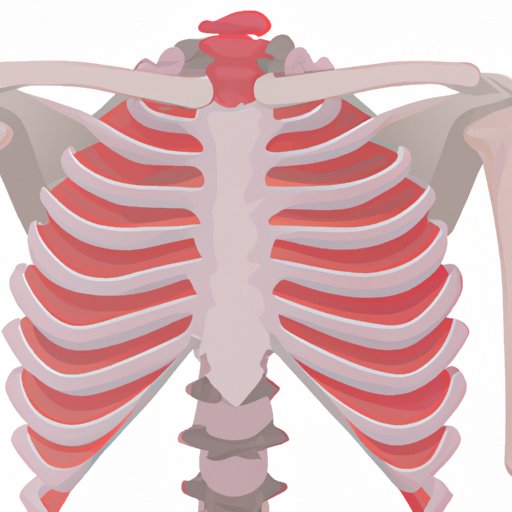Sore Ribs: When It’s More than Just a Muscle Strain
Have you been experiencing soreness or pain in your ribs lately? While it’s easy to dismiss it as a muscle strain, there are many other potential causes that require attention. In this article, we will delve into the anatomy and function of the ribcage, explore common causes of sore ribs, discuss the symptoms and treatment options, and offer strategies for prevention and management.
Ribcage Anatomy and Function
Your ribcage is a complex structure that surrounds and protects your vital organs, such as your heart and lungs. It is made up of twelve pairs of ribs that are attached to your spine and sternum. The top seven pairs are called true ribs, while the next three pairs are known as false ribs. The last two pairs are called floating ribs because they are not attached to the sternum at all.
The ribcage serves several functions, including protecting your organs, aiding in breathing by expanding and contracting during inhalation and exhalation, and supporting your upper body. The ribs are also important attachment points for muscles, including those involved in your posture and arm movements.
Unfortunately, the ribcage can also be a source of pain and discomfort.
Common Causes of Sore Ribs
Sore ribs can be caused by a variety of factors, including injury, inflammation, or underlying medical conditions. Here are some of the most frequent causes:
Rib injury or trauma
Blunt force trauma to the chest, such as a fall or a car accident, can cause rib fractures or bruising. If you are experiencing sharp pain in your ribs that worsens when you take a deep breath or cough, you may have a broken rib. Seek medical attention immediately.
Costochondritis
Costochondritis is an inflammation of the cartilage that connects your ribs to your breastbone. The pain is usually sharp and localized on one side of your chest, but it can also radiate to your arms and shoulders. It can be caused by overuse, injury, or an underlying medical condition, such as arthritis.
Muscle strain or sprain
If you have been engaging in physical activity that involves your upper body, such as weightlifting or golf, you may experience a muscle strain or sprain in your chest or back. The pain can be dull or stabbing and is usually accompanied by tenderness and swelling in the affected area. Resting and applying ice can help alleviate the pain.
Other potential causes
Other potential causes of sore ribs include infections, such as pneumonia or shingles, lung conditions, such as pleurisy or asthma, and gastrointestinal issues, such as acid reflux or gastritis. Some women may also experience rib pain during pregnancy due to the pressure on their organs caused by the growing uterus.
Symptoms and Treatment Options
Depending on the underlying cause, sore ribs can present different symptoms and require different treatment options. Here’s an overview:
Detailed discussion of each potential cause
It’s essential to identify the root cause of your rib pain before opting for any treatment. This may involve a physical exam, imaging tests, or bloodwork. Once you know what’s causing your pain, you can work with your doctor to develop an appropriate treatment plan.
Accompanying Symptoms
In addition to the pain in your ribs, you may experience other symptoms related to the underlying cause, such as difficulty breathing, fever, coughing, or swelling. These symptoms can help your doctor narrow down the potential causes and recommend the best course of action.
Treatment Options
Treatment options for sore ribs include natural and home remedies, medication, and therapy. Natural and home remedies may include stretching, hot or cold compresses, and rest. Medications, such as pain relievers or anti-inflammatories, may be recommended for certain cases. Therapy, such as physical therapy or corticosteroid injections, may be necessary for more severe conditions.
Prevention and Management
While some causes of sore ribs are unavoidable, there are strategies for preventing and managing the pain.
Importance of Prevention
Strengthening your chest and back muscles through regular exercise, maintaining good posture, and avoiding risky activities can all contribute to preventing rib pain.
Strategies for prevention
Some strategies for preventing rib pain include avoiding repetitive motions that strain your ribcage, using proper lifting techniques, gradually increasing your exercise regimen, and maintaining a healthy weight.
Management of sore ribs with medical attention
If you have persistent rib pain that is affecting your daily life, seek medical attention. Your doctor can help diagnose the underlying cause and recommend appropriate treatment.
Recommended lifestyle changes
Incorporating healthy lifestyle changes, such as quitting smoking, reducing stress, and eating a balanced diet, can also help alleviate rib pain and promote overall health.
Conclusion
When you experience rib pain, it’s essential to take it seriously and seek medical attention if necessary. By understanding the anatomy and function of the ribcage, recognizing the common causes of sore ribs, and knowing the symptoms and treatment options available, you can take steps to prevent and manage rib pain effectively.
Whether you’re an athlete, pregnant woman, or someone dealing with an underlying condition, there are options for relief and healing. Don’t live with the pain when there are solutions available.
Call for Action
Take care of your ribs by incorporating healthy lifestyle habits, consulting with your doctor when needed, and staying aware of how your body feels. By doing so, you’ll be preventing further injury and enjoying life unhindered by rib pain.
